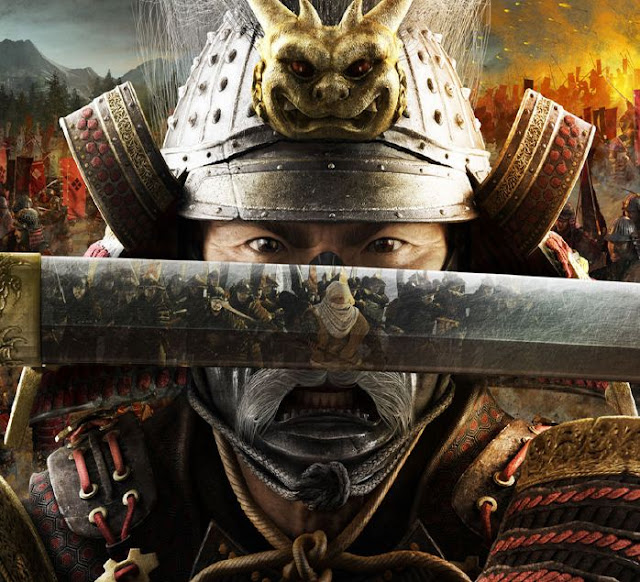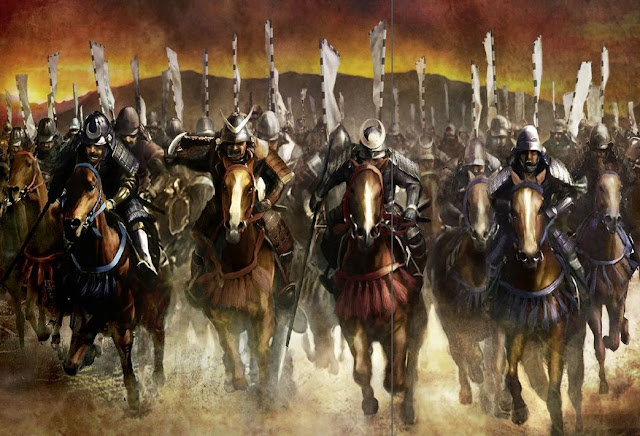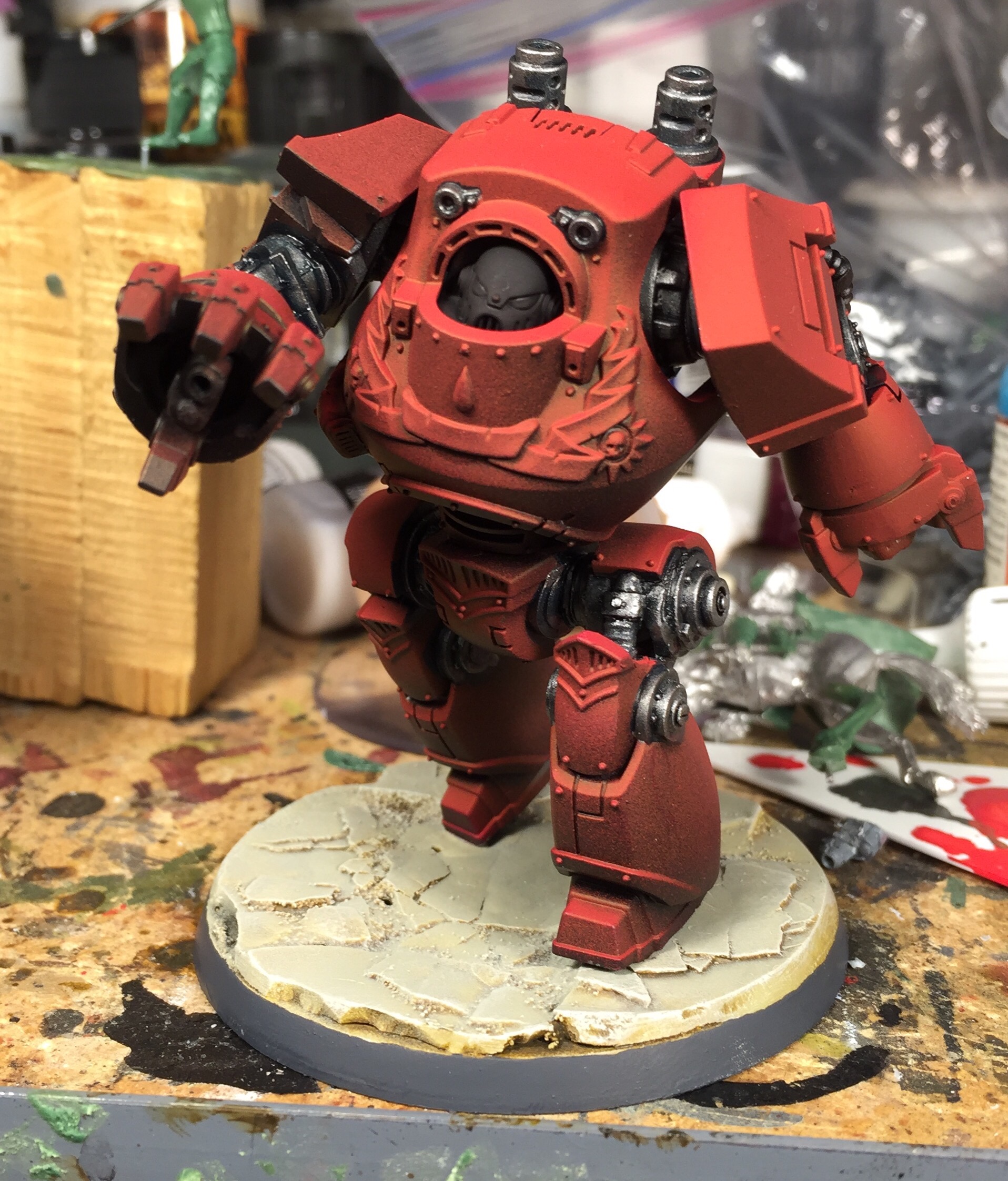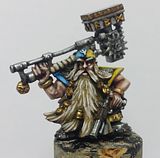A comprehensive update of the Nippon Warhammer Fantasy Battle Army for 8th Edition rules.
This army is completely unofficial and is not endorsed by Games Workshop!Mathias has just released a major revision of the Nippon Army book. This is a significant re-work of the army list and background fluff (click army book cover download and comment links).
One of the appealing reasons to play a Fantasy Battle Game with a Nippon army is that you can actually find Samurai and other suitable miniatures. If you;re really, really lucky you might even find some :-
out of production GW / Citadel Nippon minis on eBay.
(note: also try searching for "Oriental" and "Samurai")
Main changes (from Mathias' notes):-
- A new history that combines Japanese creation myth and history with links to other races in the Warhammer World incl. Cathay, Dark Elves, Skaven, Marienburg and Chaos.
- A new religion added to the Culture and Customs section.
- A Land of Nippon section which is partly based on old WHFRP material and part written by Mathias.
- All new Clans, based on 8 of the clans from Total War: Shogun II, to which Mathias has added his own background.
- All Clan Mon are completely new.
- A completely new Lore of the Kami.
- All Special Characters are new or returning from the 7th edition list.
- Sumo Warriors, Ronin, Red Devils and Kabuki Dolls are back.
- New units: Yamabushi, Wako Pirates, Great Guard, Yabusame, Battle Maidens.
- Increased casting value for Borne on the Wind.
- Mikoshi Shrine can now give blessing to all units.
- Fan of Command is now one use only, 35 pts.
- Clan Mon are now priced individually per model.
Sigmar's Nippon Review
- Summary: 102 pages, 30 meg PDF (or can be viewed online), 8th edition rules compliant.
So what's in the book...
It starts with the History of Nippon, from it's founding, the rise of the Samurai, it's various wars (including the Hobgoblin invasion, Chaos Incursions, Cathay conflict and internal strife) through to the arrival of gunpowder and the present day. The detailed and varied history should provide you with just cause for fielding the army in games against several other Warhammer races.
Following the history, which concludes with the customary timeline, the book moves onto Culture and Customs. This section details all of the society's hierarchy, religion and rituals and most importantly the "Tenets of Bushido" - which I recommend you memorise and follow to the letter if you plan to take this honourable army into battle - note that ritual suicide may be required if you suffer a shameful massacre ;-)
The book then moves onto the Clans and the Land of Nippon (beginning with a map of the islands). The clans should provide you with a bit of inspiration for customising your army and the lands section should be useful if you want to create some themed terrain and scenery and maybe for basing your miniatures. In fact, if you're a keen modeler and scenery designer, the very distinctive buildings and structures should give you a great excuse for experimentation and having a bit of fun.
The business end of the book (always my favourite part) is where the Bestiary begins. Nippon starts with the Army Special rules and there are 6 very imaginatively and appropriately thought out ideas. Reading these special rules alone will give you a taste of how well designed the army is. So here goes...
- Way of the Warrior
- - units with this rule must always accept challenges although they benefit from being able to re-roll failed psychology tests and ignore panic caused by units without the rule.
- Kenjutsu
- - unsaved wounds on the enemy can immediately be followed up by an additional attack (the extra attack does not benefit from the Kenjutsu rule)
- Death Before Dishonour
- - if a unit with this rule breaks from combat it may perform seppuku, that is, the whole unit will commit suicide thus denying the enemy a pursuit or overrun move and preventing panic from spreading throughout the Nippon army.
- Katana
- - a hand weapon that can be used as a 2 handed weapon that grants +1 to wound
- Sashimonos
- - small banners worn by Nipponese soldiers in combat for identification purposes. These banners proffer onto the unit a +1 rank bonus for Steadfast and Combat Resolution (up to +4)
- Horo Cloaks
- - Stiffened cloaks of finely woven silk that reduce the Strength of shooting attacks by 1
Do you see what I mean? I think they're pretty impressive. The fluff accompanying the rules make them sound absolutely perfect for a Nipponese army without having any detrimental impact on the "battlefield balance" of the army.
I'm going to leave the review at that, I think I've given you enough reason to have a look at the book yourself so I'll just finish with a quick summary of my thoughts and the army selection list.
- Overall, I'll just say that while I haven't tried assembling any army lists my initial impressions are that the army benefits from:-
- ...a (generally) higher than average Leadership (mostly 8, although many core units are 6); a wide variety of cheap foot and cavalry troops that should allow for a choice of tactics (not dissimilar to The Empire); and some unusual special and rare units than add some combat support and ranged offensive in the form of war machines. I haven't delved into the magic, poisons or the clan system in any depth, I'll leave that to you folks.
- The drawbacks, as with all human armies:-
- ...toughness 3 !
A quick Summary of the Nippon Army list
- A unique spell Lore, 10 magical artefacts, 8 clans and 9 poisons.
- 4 Lords, 9 Heroes,
- 5 Core units - including the Samurai of course (who are not as powerful as you may suspect, although they do have a useful Ld8, Ws4 and the special rules noted above)
- 10 Special units - including Ninjas, Warrior Monks and the unstoppable Sumo (that can force a break test re-roll in the 1st round of combat following their charge).
- 6 Rare units - including the Great Guard (devastating Monstrous Cavalry), a Mangonel, the Flaming Arrow (a cannon), the Kitsune (a useful ethereal) and the Mikoshi Shrine (which grants blessings on nearby units).




















































